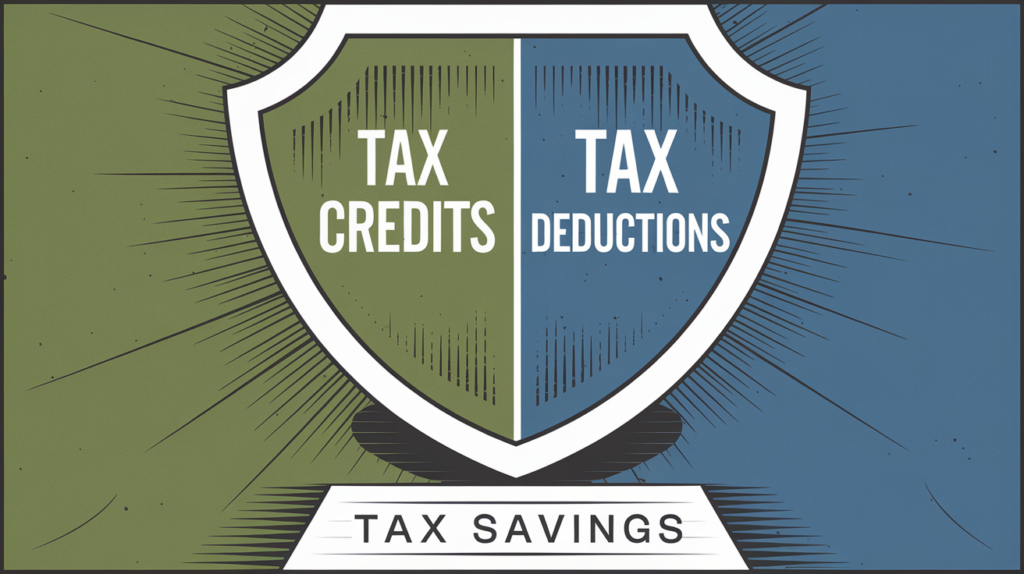Tax season doesn’t have to be a headache. At XOA TAX, we believe that knowledge is power. Understanding the ins and outs of tax credits and deductions can significantly reduce your tax liability and maybe even put some money back in your pocket! Let’s break down these essential tax tools to help you maximize your savings for the 2024 tax year (filing in 2025).
Key Takeaways
- Tax Credits: Think of these as direct discounts on your tax bill. For every dollar of credit, your tax liability decreases by a dollar.
- Tax Deductions: These reduce the amount of your income that’s subject to tax, lowering your overall tax burden.
- Types of Credits and Deductions: Both come in different forms, and knowing which ones apply to you is key.
- Eligibility: Understanding the criteria for each credit and deduction is crucial for maximizing your tax benefits.
What is a Tax Credit?
Imagine getting a $1,000 off coupon for your taxes. That’s essentially what a tax credit does – it directly reduces the amount you owe.
Types of Tax Credits:
- Refundable Credits: The best kind! If your credit exceeds your tax liability, the difference comes back to you as a refund.
- Example:
- Income Tax Owed: $1,000
- Earned Income Tax Credit: $2,500
- Tax Refund Received: $1,500
- Nonrefundable Credits: These can reduce your tax liability to zero, but you won’t receive any money back if the credit exceeds your tax bill.
- Partially Refundable Credits: Some credits are a mix of both – part of it may be refundable, and part is not.
Common Tax Credits You Should Know About:
- Child Tax Credit (CTC): Provides up to $2,000 per qualifying child to help families with children. (Note: Income limits apply and the credit begins to phase out for single filers with incomes above $200,000 and married couples filing jointly with incomes above $400,000). Many states also offer their own Child Tax Credits, so be sure to check the requirements for your state.
- Earned Income Tax Credit (EITC): Designed for taxpayers with low to moderate incomes, the EITC can provide a significant credit depending on your income and family size. For example, a married couple filing jointly with three or more qualifying children could receive a credit of up to $7,430 in 2024. (Note: Income limits apply and vary by filing status and number of children). Some states offer their own versions of the EITC, which can further boost your tax savings.
- American Opportunity Tax Credit (AOTC): If you’re pursuing higher education, this credit can help offset the cost of tuition, fees, and course materials for the first four years of post-secondary education. (Note: This credit is subject to income phase-outs and begins to phase out for single filers with incomes above $80,000 and married couples filing jointly with incomes above $160,000). Your state may also offer tax benefits for education expenses.
- Lifetime Learning Credit: This credit helps pay for courses taken to improve job skills or acquire new ones. (Note: This credit also has income limitations and begins to phase out for single filers with incomes above $80,000 and married couples filing jointly with incomes above $160,000).
- Retirement Savings Contributions Credit: This credit encourages those with low to moderate incomes to save for retirement.
What is a Tax Deduction?
A tax deduction reduces your taxable income, which ultimately lowers your tax bill. The amount you save depends on your tax bracket.
- Example:
- Taxable Income: $50,000
- Standard Deduction: $14,600 (Single filer in 2024)
- New Taxable Income: $35,400
- Assume a 22% Tax Bracket: Tax Savings = $4,600 x 0.22 = $1,012
Types of Tax Deductions:
- Standard Deduction: This is a fixed amount that everyone can take. The amount depends on your filing status.
- Itemized Deductions: If you have certain eligible expenses, like mortgage interest, state and local taxes (up to a limit of $10,000), charitable contributions, or medical expenses exceeding 7.5% of your adjusted gross income, you might be able to itemize. Keep meticulous records of these expenses!
Standard Deduction Amounts for 2024:
- Single or Married Filing Separately: $14,600
- Married Filing Jointly or Surviving Spouse: $29,200
- Head of Household: $21,900
Don’t Forget These!
If you’re 65 or older or blind, you can claim an additional amount:
- Single or Head of Household: $1,950
- Married or Qualifying Widow(er): $1,550
Standard vs. Itemized: Which is Right for You?
Use this simple guide:
- If your total itemized deductions (mortgage interest, charitable donations, state/local taxes, medical expenses) are greater than your standard deduction amount, you should itemize.
- If your itemized deductions are less than your standard deduction, stick with the standard deduction.
Tax Credit
Example:
Tax Deduction
Example (22% Tax Bracket):
Do You Qualify?
To ensure you’re claiming all the tax breaks you’re entitled to, consider these factors:
- Filing Status: Your filing status (single, married filing jointly, head of household, etc.) impacts which credits and deductions you can claim.
- Life Events: Major life changes like marriage, divorce, having a child, or buying a home can significantly affect your eligibility for certain credits and deductions.
- Income: Many tax credits and deductions are limited to taxpayers within specific income ranges.
- Stay Informed: Tax laws are subject to change. Stay updated by checking the IRS website or consulting with a tax professional.
How to Claim Tax Credits and Deductions:
Claiming Tax Credits:
- Identify Eligible Credits: Review the list of available tax credits to determine which ones apply to your situation.
- Gather Documentation: Collect all necessary documents, such as birth certificates (for the Child Tax Credit), Form 1098-T (for education credits), and any other relevant records.
- Complete the Appropriate Forms: Fill out the required IRS forms for each credit you’re claiming. You can find these forms on the IRS website: https://www.irs.gov/forms-instructions
- Submit Your Tax Return: Ensure all credits are accurately reported before filing your tax return. You can file electronically, by mail, or with the assistance of a tax professional.
Claiming Tax Deductions:
- Choose Between Standard or Itemized: Calculate whether the standard deduction or itemizing deductions provides greater tax savings.
- Gather Necessary Documentation: If itemizing, collect receipts and records of all eligible expenses.
- Complete Schedule A: For itemized deductions, fill out Schedule A of Form 1040.
- Submit Your Tax Return: Ensure all deductions are accurately reported before filing your tax return.
Important Considerations:
- Documentation is Key: Maintain thorough records of all expenses and credits claimed. This includes receipts, invoices, and any other relevant documentation. Proper documentation is essential in case of an IRS audit.
- Understanding Phase-Outs: Some tax credits and deductions have income thresholds beyond which they begin to phase out or decrease. Be aware of these limits to understand how they might affect your eligibility.
- Staying Informed: Tax laws can change frequently. Stay updated on the latest regulations by consulting IRS publications, reputable financial websites, or a tax professional.
FAQs
Which is more valuable, a tax credit or a deduction?
Generally, tax credits are more valuable because they directly reduce the amount of tax you owe, dollar for dollar. Refundable tax credits can even result in a refund if they exceed your tax liability.
Is the EV tax credit refundable?
No, the EV tax credit is nonrefundable. It can reduce the amount you owe in taxes but will not result in a refund if the credit exceeds your tax liability.
How can I ensure I qualify for both tax credits and deductions?
Review the IRS criteria based on your filing status, recent life changes, and taxable income. Stay updated on tax laws and consider consulting a tax professional for personalized guidance.
What qualifications must be met to take certain tax deductions?
Qualifications for tax deductions vary but typically include factors like your filing status, recent life changes, taxable income levels, and adherence to specific IRS guidelines. Documentation is often required to support your claims.
How does the U.S. progressive tax system impact my calculated tax?
The U.S. has a progressive tax system, meaning higher income brackets are taxed at higher rates. This means that only the income above each threshold is taxed at the corresponding higher rate.
What are the benefits of using a tax filing service?
Using a professional tax filing service like XOA TAX offers several advantages, including:
- Expertise: CPAs can identify credits and deductions you might miss.
- Accuracy: Reduced risk of errors and potential audits.
- Efficiency: Time-saving and convenient, especially for complex tax situations.
- Peace of Mind: Confidence that your taxes are filed correctly and on time.
XOA TAX: Your Partner in Navigating the Tax Landscape
We understand that taxes can be confusing, but you don’t have to go it alone. Our team of experienced CPAs can help you:
- Identify the credits and deductions you’re eligible for.
- Ensure you meet all the necessary requirements.
- Navigate complex tax laws and regulations.
- Maximize your tax savings.
- File your taxes accurately and on time.
Understanding tax credits and deductions is essential for minimizing your tax liability. By staying informed, keeping thorough records, and seeking professional guidance when needed, you can navigate the tax landscape with confidence. Contact XOA TAX today, and let us help you make the most of your tax savings!
Contact us today for a consultation!
Website: https://www.xoatax.com/
Phone: +1 (714) 594-6986
Email: [email protected]
Contact Page: https://www.xoatax.com/contact-us/
Disclaimer: This post is for informational purposes only and does not provide legal, tax, or financial advice. Laws, regulations, and tax rates can change often and vary significantly by state and locality. This communication is not intended to be a solicitation, and XOA TAX does not provide legal advice. XOA TAX does not assume any obligation to update or revise the information to reflect changes in laws, regulations, or other factors. For further guidance, refer to IRS Circular 230. Please consult a professional advisor for advice specific to your situation.




 anywhere
anywhere  anytime
anytime